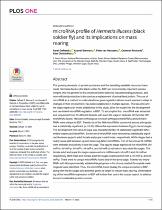| dc.contributor.author | DeRaedt, Sarah | |
| dc.contributor.author | Christoffels, Alan | |
| dc.date.accessioned | 2022-09-23T12:11:03Z | |
| dc.date.available | 2022-09-23T12:11:03Z | |
| dc.date.issued | 2022 | |
| dc.identifier.citation | DeRaedt, S., Bierman, A., van Heusden, P., Richards, C., & Christoffels, A. (2022). microRNA profile of Hermetia illucens (black soldier fly) and its implications on mass rearing. PloS one, 17(3), e0265492. https://doi.org/10.1371/journal.pone.0265492 | en_US |
| dc.identifier.uri | 10.1371/journal.pone.0265492 | |
| dc.identifier.uri | http://hdl.handle.net/10566/7961 | |
| dc.description.abstract | The growing demands on protein producers and the dwindling available resources have made Hermetia illucens (the black soldier fly, BSF) an economically important species. Insights into the genome of this insect will better allow for robust breeding protocols, and more efficient production to be used as a replacement of animal feed protein. The use of microRNA as a method to understand how gene regulation allows insect species to adapt to changes in their environment, has been established in multiple species. The baseline and life stage expression levels established in this study, allow for insight into the development and sex-linked microRNA regulation in BSF. To accomplish this, microRNA was extracted and sequenced from 15 different libraries with each life stage in triplicate. Of the total 192 microRNAs found, 168 were orthologous to known arthropod microRNAs and 24 microRNAs were unique to BSF. Twenty-six of the 168 microRNAs conserved across arthropods had a statistically significant (p < 0.05) differential expression between Egg to Larval stages. The development from larva to pupa was characterized by 16 statistically significant differentially expressed microRNA. Seven and 9 microRNA were detected as statistically significant between pupa to adult female and pupa to adult male, respectively. All life stages had a nearly equal split between up and down regulated microRNAs. Ten of the unique 24 miRNA were detected exclusively in one life stage. The egg life stage expressed five microRNA (hil-miR-m, hil-miR-p, hil-miR-r, hil-miR-s, and hil-miR-u) not seen in any other life stages. The female adult and pupa life stages expressed one miRNA each hil-miR-h and hil-miR-ac respectively. Both male and female adult life stages expressed hil-miR-a, hil-miR-b, and hil-miR-y. There were no unique microRNAs found only in the larva stage. Twenty-two microRNAs with 56 experimentally validated target genes in the closely related Drosophila melanogaster were identified. Thus, the microRNA found display the unique evolution of BSF, along with the life stages and potential genes to target for robust mass rearing. Understanding of the microRNA expression in BSF will further their use in the crucial search for alternative and sustainable protein sources. | en_US |
| dc.language.iso | en | en_US |
| dc.publisher | PloS one | en_US |
| dc.subject | pupa | en_US |
| dc.subject | Animal feed / analysis | en_US |
| dc.subject | Animals | en_US |
| dc.subject | diptera | en_US |
| dc.title | MicroRNA profile of Hermetia illucens (black soldier fly) and its implications on mass rearing | en_US |
| dc.type | Article | en_US |

